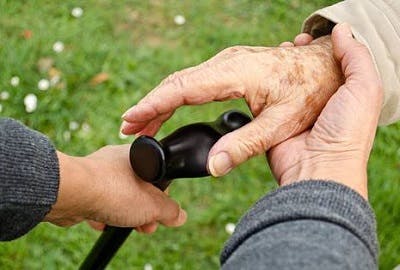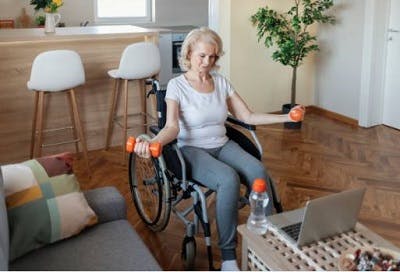After a spinal cord injury, survivors may struggle with movement in the upper extremities, which consists of the shoulder, arms, elbows, and hands. To improve function, survivors must engage in upper extremity exercises for spinal cord injury rehabilitation.
This article will explore the various types of upper extremity exercises for spinal cord injury survivors, including wheelchair-friendly exercises. First, let’s take a look at the benefits of exercising after spinal cord injury and how a home exercise program can help you stay motivated throughout recovery.
Why is Exercise Necessary After Spinal Cord Injury?
The spinal cord serves as a communication pathway between the brain and the rest of the body. When this pathway is disrupted, the brain is unable to send signals to move specific muscles, resulting in impaired movement. The specific muscles affected depend on the level of injury.
Low-level injuries affect the lower extremities, whereas high-level injuries affect both the upper and lower extremities. For example, individuals with lumbar-level injuries may experience weakness in the legs while individuals with cervical or high-thoracic level injuries may experience weakness in the hands and lower extremities.
Fortunately, the spinal cord is extremely adaptable and can reassign function via neuroplasticity, the central nervous system’s ability to rewire itself. Neuroplasticity is essential for recovery and is best activated through high-repetition of exercises, or massed practice.
The more demand for a function, such as movement, the more the nervous system strengthens its neural pathways. Therefore, to improve function and maximize recovery, it’s important to practice spinal cord injury exercises as much as you can.
Types of Upper Extremity Exercises for Spinal Cord Injury
Every spinal cord injury is different, and survivors may experience various motor difficulties that require a unique rehabilitation plan. However, there are a few key elements that should be included in your upper extremity exercises after spinal cord injury. This includes stretching, passive range of motion, strength-training, and aerobic exercises.
Each type of exercise targets different muscle groups and helps stimulate neuroplasticity to promote recovery. Be sure to work with a therapist to make sure these exercises are safe and suitable for your ability level.
Here are the types of upper extremity exercises for spinal cord injury:
Stretching Exercises for Spinal Cord Injury

After a spinal cord injury, some survivors may experience spasticity, a condition in which the muscles tighten up. When spasticity is unmanaged, it can lead to a condition known as contractures where the joints become painfully stiff. A great way to prevent contractures from developing is to stretch and move your upper body joints through their full range of motion.
Stretching can also help promote blood flow in the body after spinal cord injury. Therefore, it’s highly encouraged to begin every workout with a gentle stretching routine.
Upper extremity stretching exercises after spinal cord injury can include:
1. Shoulder Rolls
For this exercise, shrug your shoulders and slowly move them in circular motions backward. Backwards motions are especially beneficial for survivors in wheelchairs who use their upper body to push themselves around.
2. Arm Circles
This stretch can be done using one arm at a time or both. Spread your arms out to the sides and align them with your shoulders. Then, slowly make large circles forward and backward for a couple of seconds.
3. Cross-Body Shoulder Stretch
Pull one arm across your body and bend your other arm to hold it in place. Gently pull your arm further across your body until you feel the stretch and then hold for as long as you can. Then alternate with the other arm. Make sure to stop if you feel any pain when stretching.
4. Overhead Triceps Stretch
To stretch your triceps, raise one arm as high as you can then bend your elbow until your hand is behind your head or back. Use the other arm to press down on the elbow and slowly stretch. Then repeat with the other arm.
5. Wall-Chest Stretch
For this stretching exercise, position yourself next to a wall or by a doorway. Extend your arm out to the side and place the palm and inner arm against the wall with your elbow slightly bent. Gently lean forward and rotate your body to the opposite side until you feel a pull. Then repeat with the other side. Make sure to stop or slow down if you feel pain when stretching.
6. Wrist Flexion & Extension Stretch
For this stretching exercise, place one arm out in front of you and with your other arm, push the back of the palm down to make a 90° angle facing the floor. Hold for a few seconds and then push the palm back up with your fingers facing the ceiling. Then alternate with the other wrist. If at first it’s difficult to practice this stretch with your arm out in front of you, you can complete it with your elbow bent at your side to build strength.
7. Interlocked Fingers Stretch
Lastly, stretching your fingers can also help promote blood flow in your hands. For this exercise, bring your hands together and interlock your fingers. Then slowly straighten your arms out in front of you and gently twist your wrists so that the backs of your hands are facing you. Hold for a couple seconds but make sure not to exert more force than you can.
Passive Range-of-Motion Exercises for Spinal Cord Injury

To improve movement after spinal cord injury, individuals must repeatedly practice affected movements to encourage neuroplasticity. You can think of the phrase “use it or lose it” to motivate yourself to practice.
Neuroplasticity is occurring all the time, but to enhance it after an injury you must engage in massed practice. The more a skill or function is practiced, the more the brain will strengthen its neural pathways to improve that function. Therefore, passive range of motion exercises are extremely beneficial in restoring motor skills after spinal cord injury.
Passive range of motion exercises do not require you to use excessive force or energy. Rather, a therapist or caregiver assists you by moving your body for you. However, as long as you pay attention to the movement while you practice, passive exercise still helps activate neuroplasticity.
Furthermore, individuals who have more control over their movements are encouraged to try to actively perform these range of motion exercises on their own, once cleared by a therapist.
Here are some of the most effective passive range of motion exercises you can try with your caregiver or therapist:
8. Elbow Flexion
First, gently move your forearm toward your upper arm as much as you can without pain. Then extend your arm and repeat with your opposite arm. The angle created between your upper and lower arm is flexion.
9. Straight Push
For this passive range of motion exercise, grab a water bottle or something similar that you can place on the table. Then, clasp your hands together and place your arms on the table. Place the water bottle in front of you as your target.
Slowly glide your arms across the table towards the water bottle. Try to stretch as you lean forward and push the water bottle further away. Then, return to an upright position. Repeat a few times or as much as you can, and try to stretch a bit further each time.
10. Circle Movement
Also using a water bottle, lace your fingers together and wrap both hands around the water bottle on the table. Then, slowly make large circular movements with your arms. As you move in circular motion, focus on stretching your affected arm. After moving in one direction, also try to reverse. One direction helps build strength, while the opposite direction helps reduce tension.
11. Hand Raises
Start this passive range of motion exercise with your arm relaxed to the side, with your fingers facing your feet and the palm facing your side. Keeping the arm straight and, with the help of your caregiver or on your own, raise your hand forward and up so that your fingers face up toward the ceiling.
12. Cane Reach
For this exercise, grab a cane and hold both of the ends. Then, gently lift your affected arm up (you can rest the cane on your leg for extra support). Hold this arm stretch for a few seconds or as long as you can and gently release it.
For an added challenge, turn your head and rotate your trunk towards that side. This is a great upper extremity exercise for the shoulders. However, it’s important to take breaks and only do what you can handle to avoid overstraining your shoulders.
Ask your therapist or caregiver to take over if you tire out quickly. As you practice more consistently, your endurance will improve.
Strength-Training Upper Extremity Exercises for Spinal Cord Injury

Generally, everyday movements such as walking, standing, and lifting objects are enough to maintain your current level of muscle mass. However, after a spinal cord injury, these daily activities can be more difficult to accomplish. This lack of activity can cause muscles to shrink (muscle atrophy). Fortunately, survivors can engage in strength-training exercises that help lower the risk of muscle atrophy and stimulate neuroplasticity.
You can rebuild strength by adding weight or resistance to any of the upper extremity exercises mentioned above. For example, when doing elbow flexion you can hold a dumbbell to increase the difficulty and stimulate muscle growth. Be mindful when doing any exercises with added weight to avoid the risk of injury or overworking your muscles.
Here are some upper extremity exercises for spinal cord injury that help rebuild strength:
13. Wheelchair Pushups
For this exercise, first and foremost, make sure the brakes are engaged and your wheelchair is secured. Then, put your hands on the armrests and straighten your arms. Slowly lift yourself up from the seat of the chair and slowly sit back down.
14. Bicep Curls
Place your arms as close to your trunk as possible while holding a dumbbell in either one or both hands. The face of your palms and inner arm should be facing up. Without moving your upper arm, bring the dumbbell up towards your shoulder, hold it for a second if you can, and then bring it back down.
15. Triceps Extensions
Hold a weight such as a medicine ball or dumbbell with both of your hands and slowly raise it over your head. Then gently lower the weight behind your head to bend your elbows. Lift the weight back up and straighten out your arms. Start with a light weight and work your way up as you build more strength.
16. Pushing Your Wheelchair
Maneuvering yourself on a wheelchair is a great way to rebuild arm and shoulder strength. To increase the difficulty level, you can push yourself around for longer distances. Many spinal cord injury survivors overwork their arm and shoulder muscles during wheelchair use, therefore it’s important to only attempt this exercise if you do not feel tired. Remember to stop and take breaks if you feel fatigued.
Aerobic Upper Extremity Exercises for Spinal Cord Injury

Aerobic exercise is a great way to promote blood circulation throughout the body while also stimulating the nervous system. Aerobic exercises for the upper body tend to be more advanced, but there are ways to slowly work your way up to more difficult exercises.
Below are some of the most effective aerobic upper extremity exercises that mimic the same movements used in sports. These exercises can be done in a sitting or standing position, but make sure to stop if you feel any pain or discomfort. For more guidance and assurance, ask your therapist which aerobic exercises are right for you.
Here are some upper extremity aerobic exercises for spinal cord injury:
17. Rowing
This upper extremity exercise mimics the movements done in rowing. Place your arms out in front of you and then slowly bend your elbows and pull your arms back in towards your body. You should feel your shoulder blades squeezing together on your back as you row.
18. Swim Strokes
Mimicking swimming strokes can help stimulate blood flow and rebuild arm strength. These can include backstrokes, butterfly, freestyle, and breaststrokes. You can practice different swimming strokes sitting down in your wheelchair or wherever you feel the most comfortable. For instance, take one arm and slowly push it forward and alternate with your other arm as if you were in a swimming pool.
Swimming is one of the best aerobic exercises because it targets a variety of muscle groups. Once cleared by your therapist, you may be able to try aquatic therapy for spinal cord injury.
19. Boxing
Just like swimming, boxing involves a variety of different arm motions that help exercise the upper body. For this exercise you don’t need a punching bag, you can simply mimic the different types of arm motions, or punches such as the jab, hook, uppercut, and cross. These motions can get your heart pumping and strengthen your arms.
20. Hand Cycling
Handcycles are bikes where individuals pedal with the arms instead of the legs. This is a great upper extremity exercise for spinal cord injury survivors because it mimics the same arm motions and helps stimulate the heart and brain.
Strength-training, aerobic exercises, and stretching techniques are all essential to improve upper body mobility and overall function. While your therapist can provide the equipment you need to engage in upper extremity exercises for spinal cord injury, it can be helpful to invest in your own physical therapy tools. This way, you can practice however much you’d like from the comfort of your own home, and at your own pace.
How to Stay Motivated While Exercising at Home
After your therapy session, your therapist may provide you with sheets of exercises you can do at home. While these sheets are helpful, it can be difficult to stay motivated and practice high-repetition of exercises by yourself.
Therefore, to help you stay extra motivated to practice upper extremity exercises at home, you can try gamified neurorehabilitation devices such as FitMi and MusicGlove. Both are interactive home exercise programs that are great for spinal cord injury survivors to engage in in between therapy sessions.
MusicGlove is a hand-therapy device designed to improve dexterity in the hands. This device is especially attractive because it combines music, gaming, and hand therapy exercises to help you stay motivated and practice high-repetition exercises. MusicGlove encourages individuals to practice 100 repetition exercises in a 30 minute session. In fact, MusicGlove has been clinically proven to boost hand function in just 2 weeks!
FitMi is another neurorehab device designed to improve mobility after spinal cord injury. It provides survivors with full-body rehab exercises that target a variety of muscle groups including the arms and shoulders. FitMi motivates you to practice high-repetition of upper extremity exercises based on your ability level. It also unlocks more challenging exercises as you improve and keeps track of your progress.
MusicGlove and FitMi are popular neurorehab devices that promote high-repetition exercises in a fun, engaging way. They provide a great way to stimulate neuroplasticity in the spinal cord and boost motor recovery.
Engaging in Upper Extremity Exercises After Spinal Cord Injury
While a spinal cord injury can cause a variety of secondary effects such as paralysis, limited mobility, and spasticity, there are many ways to improve function. To rebuild strength and restore movement in the upper body, survivors must engage in upper extremity exercises for spinal cord injury.
Exercise in general has many benefits such as promoting blood flow and stimulating the brain to activate neuroplasticity, which is necessary to improve function. High-repetition of exercises, especially, are essential to strengthen the neural pathways for all functions.
The more you practice consistently, the more you engage your muscles, and the more familiar the nervous system becomes with the movements. Remember to start with exercises based on your ability level and work your way up to more complex exercises.
We hope these upper extremity exercises for spinal cord injury encourage you to stay engaged in the rehabilitation process and maximize recovery.
The post Upper Extremity Exercises for Spinal Cord Injury Survivors to Improve Mobility appeared first on Flint Rehab.



